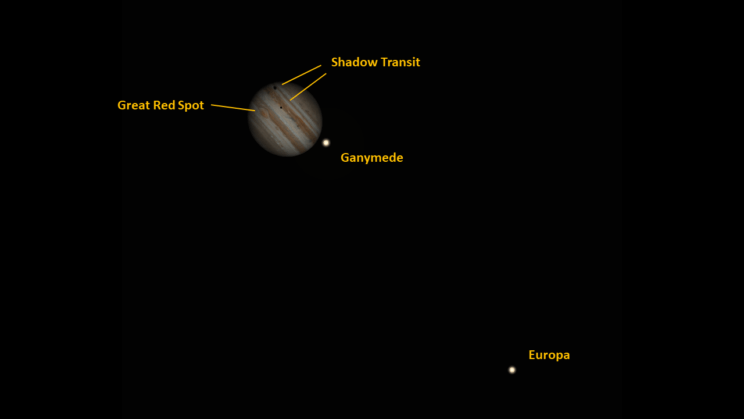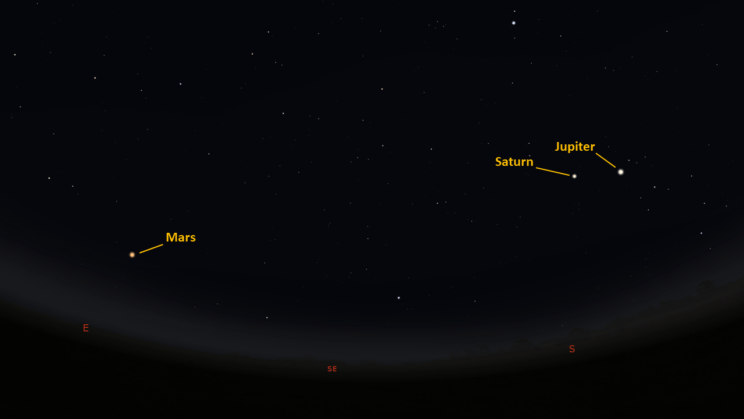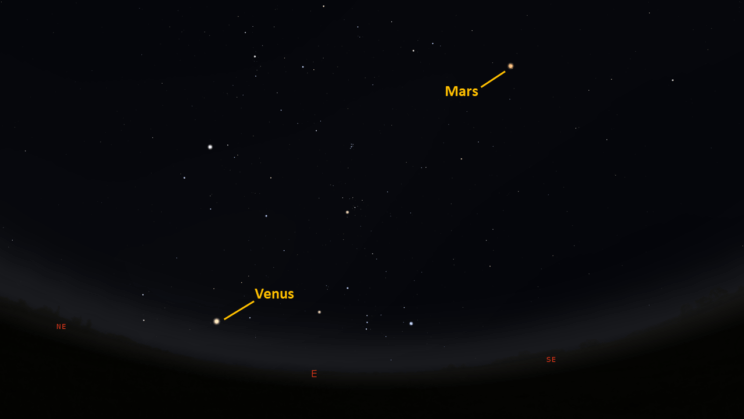This is the Saint Louis Science Center’s NIGHT SKY UPDATE for the week of Friday, August 21, 2020.
Information updated weekly or as needed.
Times given as local St. Louis time (CDT). For definitions of terminology used in the night sky update, click the highlighted text.
Public Telescope Viewings
Star parties at the Saint Louis Science Center have temporarily been canceled due to recommendations from the CDC regarding COVID-19. All public telescope events are canceled until further notice. As conditions change, we will reevaluate and update this article once public observing events resume.
Observing Highlight of the Week

Simulated view of Jupiter at 1:45 am August 22, 2020
Credit: Stellarium, EG
This week we will focus on the giant planet Jupiter. This is one of five planets that were known to ancient astronomers as wandering stars. Watching the behaviors of these planets (Mercury, Venus, Mars, Jupiter and Saturn) is part of what led to the discovery of our solar system. This week Jupiter can be found in the southern skies from sunset to about 3:00 a.m. as it transits the sky from southeast to southwest.
Beyond the bright object we see with our unaided eyes, Jupiter makes for a nice binocular target. Through most binoculars, you will be able to see four of Jupiter’s 79 known moons. The four moons visible through binoculars are called the Galilean Moons as they were first discovered by Galileo. Individually they are named Io, Europa, Ganymede and Callisto.
Pointing a telescope at Jupiter is when the giant planet really starts to shine. Small telescopes will reveal cloud bands in Jupiter’s atmosphere. The clouds will display an alternating dark light banded appearance. Through larger telescopes you will find these cloud features to be dynamic revealing that much like in Earth’s atmosphere there are weather changes occurring Jupiter’s. The best known of these weather features is the Great Red Spot (GRS). The GRS is a large storm that has existed for well over a century. Some resources suggest it could be over 300 years old. This Jovian feature is quite amazing due to its longevity and large size. The GRS is a storm which is larger than Earth. A day on Jupiter is only about 10 hours long, which means the GRS will not always be facing us. To spot the GRS you will need to do some research to know when it will be visible. This week there are three good opportunities to catch the GRS.
Lastly, this week also provides us with three opportunities to see shadow transits. These are events similar to solar eclipses seen on Earth. When the Galilean Moons pass between the Sun and Jupiter, their shadows will be cast onto the cloud tops of Jupiter. Their shadows will appear as small dark circles transiting the visible face of Jupiter.
A double shadow transit occurs on August 22 starting around 1:00 a.m. when Io’s shadow becomes visible followed later by Ganymede’s. A single shadow transit occurs on August 23 when Io’s shadow transits Jupiter from roughly 7:30 p.m. to 9:30 p.m. Lastly, a single shadow transit occurs on August 25 when Europa’s shadow transits Jupiter from midnight until Jupiter sets.
Make sure to check out Jupiter this week as there is a lot going on with it for us to enjoy. Also remember to keep an eye on Jupiter and Saturn as they head towards their great conjunction on December 21, 2020. An event 20 years in the making,
The Sun and Moon

The Moon as seen from the International Space Station, on July 31, 2011.
Credit: NASA
Sunrise is at 6:21 a.m. on Friday, August 21 and sunset is at 7:46 p.m. providing us with about 13.5 hours of daylight. Even after sunset, the light from the Sun will dimly illuminate our sky for about 1 hour and 40 minutes. This period is called twilight, which ends around 9:23 p.m. this week. For those with a sundial, local noon occurs around 1:04 p.m. this week.
| Day | Sunrise | Sunset |
|---|---|---|
| 2020-08-21 | 6:21 a.m. | 7:46 p.m. |
| 2020-08-22 | 6:22 a.m. | 7:45 p.m. |
| 2020-08-23 | 6:23 a.m. | 7:44 p.m. |
| 2020-08-24 | 6:24 a.m. | 7:42 p.m. |
| 2020-08-25 | 6:25 a.m. | 7:41 p.m. |
| 2020-08-26 | 6:26 a.m. | 7:39 p.m. |
| 2020-08-27 | 6:26 a.m. | 7:38 p.m. |
| 2020-08-28 | 6:27 a.m. | 7:36 p.m. |
| 2020-08-29 | 6:28 a.m. | 7:35 p.m. |
Moon
Moonrise for Friday, August 21 occurs at 9:09 a.m. and moonset will occur at 9:45 p.m. On Friday, August 21 the Moon will exhibit a waxing crescent phase with about 9% of the lunar disk illuminated. First quarter moon occurs on August 25 at 12:58 p.m.
International Space Station (ISS) Observing

Visible passes of ISS from St. Louis for the week of August 21 occur during morning hours. The best passes this week occur on August 25 and 28. Use the table below for information about these and other visible passes this week.
Catch ISS from St. Louis starting Friday, August 21
| Date | Starts | Max. altitude | Ends | |||||||
|---|---|---|---|---|---|---|---|---|---|---|
| Time | Alt. | Az. | Time | Alt. | Az. | Time | Alt. | Az. | ||
| 23 Aug | -1.3 | 05:19:38 | 10 | S | 05:21:54 | 17 | SE | 05:24:11 | 10 | E |
| 25 Aug | -3.3 | 05:20:48 | 17 | SSW | 05:23:09 | 54 | SE | 05:26:28 | 10 | ENE |
| 26 Aug | -2.4 | 04:35:20 | 29 | SE | 04:35:36 | 30 | SE | 04:38:34 | 10 | ENE |
| 27 Aug | -3.2 | 05:22:44 | 22 | W | 05:24:36 | 47 | NW | 05:27:52 | 10 | NE |
| 28 Aug | -3.7 | 04:37:06 | 76 | NNE | 04:37:06 | 76 | NNE | 04:40:16 | 10 | NE |
Magnitude (Mag): The Measure of brightness for a celestial object. The lower the value is, the brighter the object will be.
Altitude (Alt): The angle of a celestial object measured upwards from the observer’s horizon.
Azimuth (Az): The direction of a celestial object, measured clockwise from an observer’s location with north being 0°, east being 90°, south being 180° and west being 270°.
For information about ISS flyovers and other visible satellites, visit www.heavens-above.com
Detailed information regarding all unmanned exploration of our universe, missions past, present, and planned, can be found at Jet Propulsion Laboratories:
The Visible Planets

Looking Southeast, at 11:30 pm, August 21, 2020
Credit: Stellarium, EG

Looking East, 3:30 am, August 22, 2020
Credit: Stellarium, EG
This week, four naked eye planets are visible. Jupiter and Saturn rise before sunset. Look for them in the southeast once it is dark. Mars rises in the late evening and will be best seen after midnight. Venus can be found in the eastern sky before sunrise.
For those tracking Jupiter and Saturn as they approach their great conjunction later this year, the two gas giants currently appear about 8.3° apart in the sky. Jupiter appears to be moving away from Saturn right now due to retrograde motion. This is all an illusion caused by Earth passing by slower moving Jupiter. Saturn is also exhibiting retrograde motion. If you keep watching these planets as 2020 progresses, you will see some interesting behaviors that inspired early astronomers to track the skies.
Venus
Venus is well into another morning apparition. After months of seeing Venus in the west after sunset Venus is now visible in the east before sunrise. Venus rises at 2:48 a.m. and will be easily seen by 3:30 a.m. Venus remains a morning object until March 26, 2021 when it reaches superior conjunction. Since Venus has passed greatest western elongation, it will start to exhibit a gibbous phase. This week disk illumination for Venus will start at 51% and end at 55%.
Mars
The red planet rises around 10:19 p.m. and will be high enough to see in the southeast by 11:20 p.m. Opposition for Mars occurs on October 13, 2020. As we head towards this date Mars will appear brighter and larger through a telescope improving surface details. Surface features are already visible when viewing conditions are favorable. Current apparent brightness of Mars is -1.6 magnitude.
Jupiter
Look for Jupiter in the southeast about 30 minutes after sunset. Jupiter will set at 3:01 a.m. Those with a telescope can enjoy views of Jupiter’s cloud features and the Great Red Spot when it is pointed towards Earth.
Saturn
Look for the ringed planet in the southeast about 30 minutes after sunset. Saturn sets at 3:42 a.m. For those with a telescope keep track of the orientation of Saturn’s rings. Since Saturn is tilted on its rotational axis, we cross the plane of Saturn’s ring every 13 to 15 years. We are headed towards another ring plane crossing on March 23, 2025. Over the next five years you will notice Saturn’s rings will gradually incline towards an edge on appearance.
2020 Great Conjunction
This year the planets Jupiter and Saturn will reach conjunction. A conjunction is when two or more celestial bodies share the same right ascension. For Jupiter and Saturn this astronomical event occurs every 20 years. The conjunction occurs on December 21, 2020. You will find the two planets close together in the southwest just after sunset on this date.
Visit the James S. McDonnell Planetarium for more information on what’s up!
Night Sky Update: August 21-August 29, 2020






